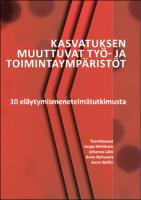Kasvatuksen muuttuvat työ- ja toimintaympäristöt
10 eläytymismenetelmätutkimusta
| dc.contributor.editor | Härkönen, Saaga | |
| dc.contributor.editor | Lätti, Johanna | |
| dc.contributor.editor | Rytivaara, Anna | |
| dc.contributor.editor | Wallin, Anna | |
| dc.date.accessioned | 2022-03-16T14:12:04Z | |
| dc.date.available | 2022-03-16T14:12:04Z | |
| dc.date.issued | 2022 | |
| dc.identifier | OCN: 1313557239 | |
| dc.identifier.uri | https://library.oapen.org/handle/20.500.12657/53399 | |
| dc.description.abstract | This edited book is the third in a series of yearbooks that introduces the principles and applicability of the method of empathy-based stories. The book presents ten empirical studies which all use this method as a tool for data collection. In addition, the work examines the reliability of the method of empathy-based stories as a method and as part of qualitative research. The research articles in the book provide a current overview of the change in different work and operating environments. These environments include various educational institutions from elementary school to universities, social media, and human resource management. Studies examine the social inclusion, participation and agency of pupils, students, young people, and professionals, as well as the professional and ethical challenges of those working in new environments. The method of empathy-based stories is used to observe, for example, university students’ interpretations of involvement in the curriculum process, pupils' views on co-teaching, different forms of agency of young people who experience sexual harassment online, and the subjectivity of recruiters and the reasons for recruitment choices. Methodologically, the book focuses on the reliability of the method of empathy-based stories and considers the characteristics of the method among qualitative research methods. Reflecting on the research articles, the work discusses what kind of requirements and challenges the method poses for both the researcher and the respondents. The book provides guidelines for evaluating the reliability of the method of empathy-based stories, while participating also in a general discussion of the reliability, potential, and limitations of qualitative research. The book indicates how the method of empathy-based stories can be applied to a wide variety of research in different contexts. The strength of the method is its ability to utilize the respondents' imagination, thus providing the researchers with opportunities to find new perspectives and invent propositions. The book also provides practical examples of how the method can be used in research. | en_US |
| dc.language | Finnish | en_US |
| dc.subject.classification | thema EDItEUR::J Society and Social Sciences::JN Education | en_US |
| dc.subject.classification | thema EDItEUR::G Reference, Information and Interdisciplinary subjects::GP Research and information: general::GPS Research methods: general | en_US |
| dc.subject.other | method of empathy-based stories, narratives, inclusion, agency, professionalism, education, working environment, recruitment of employee, eläytymismenetelmä, kertomukset, osallisuus, toimijuus, ammatillisuus, kasvatus, työympäristö, työntekijän rekrytointi | en_US |
| dc.title | Kasvatuksen muuttuvat työ- ja toimintaympäristöt | en_US |
| dc.title.alternative | 10 eläytymismenetelmätutkimusta | en_US |
| dc.type | book | |
| oapen.abstract.otherlanguage | Kasvatusinstituutiot peruskoulusta yliopistoon ovat jatkuvan muutoksen keskiössä. Globaalit ja paikalliset yhteiskunnalliset muutokset, kuten esimerkiksi sosiaalisen median levittäytyminen osaksi arkea tai synnytyssairaaloiden keskittäminen, asettavat ammattilaisille uusia osaamisvaatimuksia sekä eettisiä haasteita. Kokoomateoksen kymmenessä tutkimusartikkelissa tarkastellaan eläytymismenetelmän avulla näiden muuttuvien ympäristöjen vaikutusta niissä toimivien ihmisten arkeen. Tutkimusartikkeleissa käsitellään esimerkiksi oppilaiden näkemyksiä yhteisopettajuudesta, kätilöiden osaamista, rekrytoijien ammattitaitoa sekä seksuaalista häirintää verkossa kohtaavien nuoren toimijuutta. Menetelmällisen painotuksensa ansiosta teosta voi hyödyntää myös eläytymismenetelmän soveltamistapoja kuvaavana oppikirjana. Teos on kolmas osa vuosikirjasarjassa, joka esittelee eläytymismenetelmän käyttöä tutkimusmenetelmänä. Teos osallistuu ajankohtaiseen keskusteluun laadullisen tutkimuksen luotettavuudesta hahmottamalla menetelmän käytettävyyden mahdollisuuksia ja rajoja sen metodologisten erityispiirteiden kautta. | en_US |
| oapen.relation.isPublishedBy | a58c317d-aa1d-4cda-913b-073587647c91 | en_US |
| oapen.relation.isbn | 9789523590359 | en_US |
| oapen.pages | 349 | en_US |
| oapen.place.publication | Tampere | en_US |

